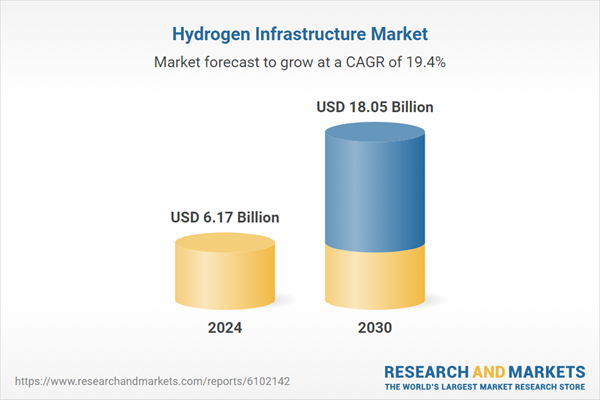Speak directly to the analyst to clarify any post sales queries you may have.
10% Free customizationThis report comes with 10% free customization, enabling you to add data that meets your specific business needs.
Green hydrogen, generated via renewable-powered electrolysis, is drawing significant attention due to its potential in achieving net-zero targets. Governments worldwide are backing the hydrogen economy through funding, strategic roadmaps, and regulatory incentives. As a result, infrastructure for hydrogen production, storage, transportation, and refueling is expanding rapidly. Large-scale initiatives such as the NEOM green hydrogen project in Saudi Arabia and widespread deployment of hydrogen refueling stations across regions like Europe, North America, and Asia-Pacific exemplify the accelerating pace of development in this sector.
Key Market Drivers
Government Policies & Incentives
Supportive government policies and financial incentives are major catalysts for hydrogen infrastructure development. The United States, for example, has allocated USD 9.5 billion for clean hydrogen under its infrastructure legislation, including tax credits of up to USD 3/kg for hydrogen production. Germany committed Euro 9 billion to its National Hydrogen Strategy and surpassed 100 hydrogen refueling stations by 2023. France plans to invest Euro 7 billion in hydrogen infrastructure by 2030, primarily for industrial decarbonization. South Korea is targeting 310 hydrogen stations by 2030, underpinned by USD 300 million in annual subsidies. Similarly, Japan is aiming for 900 stations and 800,000 fuel cell vehicles by the same year. These policy frameworks are enabling hydrogen deployment by improving project economics, reducing investment risk, and building a foundation for long-term industry growth.Key Market Challenges
High Capital Investment Requirements
Developing hydrogen infrastructure requires substantial capital expenditure, creating a significant barrier to widespread adoption. The cost of electrolyzers, essential for green hydrogen production, can range from USD 500 to USD 1,200 per kW. Refueling stations also entail high setup costs, typically between USD 1 million and USD 4 million per site - much higher than conventional fueling alternatives. Additionally, hydrogen storage and transportation infrastructure involves complex and expensive engineering, especially for high-pressure or liquefied systems.Building dedicated hydrogen pipelines or transport vessels adds further capital intensity. The absence of stable demand or long-term offtake agreements in early-stage projects increases investor risk. Financing challenges are more acute in developing economies, where public funding is limited. Without comprehensive support mechanisms, including subsidies and de-risking measures, many projects face delays or cancellation. This capital-heavy nature of hydrogen infrastructure hinders market scalability and deters new entrants.
Key Market Trends
Expansion of Hydrogen Refueling Infrastructure
A prominent trend in the hydrogen infrastructure market is the growing deployment of hydrogen refueling stations (HRS) to support fuel cell electric vehicles (FCEVs). By 2023, the global number of HRS exceeded 920, up from around 330 in 2018. Japan leads globally with over 160 operational stations and aims for 900 by 2030. Germany has surpassed 100 public stations under its H2 Mobility initiative, while South Korea plans to build 310 stations by 2030. California’s roadmap targets 200 public stations by 2025, and China had over 350 operational stations by the end of 2023. These networks are crucial for FCEV deployment, particularly for commercial fleets requiring fast refueling and extended range.Modern stations are incorporating 700-bar and 350-bar systems to serve both passenger and heavy-duty vehicles. In addition, many sites now feature on-site electrolysis for localized green hydrogen production. Enhanced digital integration, such as automated dispensing, remote monitoring, and mobile app connectivity, is also improving station efficiency and user accessibility. As FCEV manufacturers scale their offerings, the build-out of refueling infrastructure is expected to accelerate further, especially along freight corridors and urban transport networks.
Key Market Players
- Linde plc
- Air Liquide
- Air Products & Chemicals
- Uniper SE
- McPhy Energy S.A.
- Xebec Adsorption
- ITM Power PLC
- Nel ASA
- Siemens Energy
- Cummins Inc.
Report Scope:
In this report, the Global Hydrogen Infrastructure Market has been segmented into the following categories, in addition to the industry trends which have also been detailed below:Hydrogen Infrastructure Market, By Product Type:
- Hydrogen Production
- Hydrogen Storage
- Hydrogen Distribution
- Hydrogen Dispensing
Hydrogen Infrastructure Market, By End User:
- Industrial
- Transportation
- Power Generation
- Commercial & Residential
Hydrogen Infrastructure Market, By Source:
- Blue Hydrogen
- Green Hydrogen
- Grey Hydrogen
Hydrogen Infrastructure Market, By Region:
- North America
- United States
- Canada
- Mexico
- Europe
- Germany
- France
- United Kingdom
- Italy
- Spain
- South America
- Brazil
- Argentina
- Colombia
- Asia-Pacific
- China
- India
- Japan
- South Korea
- Australia
- Middle East & Africa
- Saudi Arabia
- UAE
- South Africa
Competitive Landscape
Company Profiles: Detailed analysis of the major companies present in the Global Hydrogen Infrastructure Market.Available Customizations:
With the given market data, the publisher offers customizations according to a company's specific needs. The following customization options are available for the report.Company Information
- Detailed analysis and profiling of additional market players (up to five).
This product will be delivered within 1-3 business days.
Table of Contents
Companies Mentioned
- Linde plc
- Air Liquide
- Air Products & Chemicals
- Uniper SE
- McPhy Energy S.A.
- Xebec Adsorption
- ITM Power PLC
- Nel ASA
- Siemens Energy
- Cummins Inc.
Table Information
| Report Attribute | Details |
|---|---|
| No. of Pages | 185 |
| Published | June 2025 |
| Forecast Period | 2024 - 2030 |
| Estimated Market Value ( USD | $ 6.17 Billion |
| Forecasted Market Value ( USD | $ 18.05 Billion |
| Compound Annual Growth Rate | 19.4% |
| Regions Covered | Global |
| No. of Companies Mentioned | 10 |









